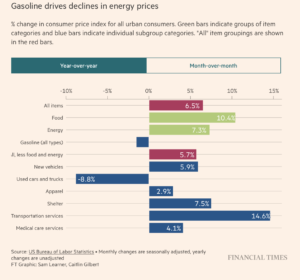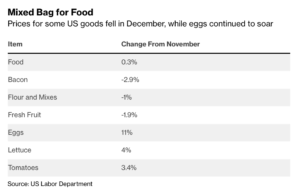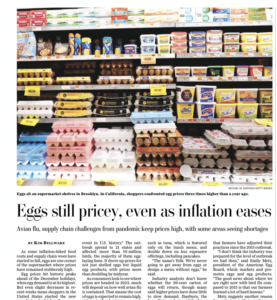Agriculture leaders in the United States House of Representatives are looking to provide at least an additional $10 billion in farmer aid to supplement the recently announced Farmer Bridge Assistance…
Food Prices Increased 0.3% in December, Up 10% From a Year Ago- Eggs Climb 59.9% Annually
Financial Times writers Colby Smith and Kate Duguid reported yesterday that, “Annual US inflation fell in December to its lowest level in more than a year, in a further sign that price pressures have peaked amid the Federal Reserve’s historic campaign to tighten monetary policy.
“The consumer price index, published by the Bureau of Labor Statistics on Thursday, declined for a sixth consecutive month, registering an annual increase of 6.5 per cent.”

Rachel Siegel reported on the front page of today’s Washington Post that, “The rate of food cost increases improved to 0.3 percent in December, down from 0.5 percent in November.”
Bloomberg writer Michael Hirtzer reported yesterday that, “Still, food prices are up 10% from a year ago.
The #food at home index rose 11.8 percent over the last 12 months.
— FarmPolicy (@FarmPolicy) January 12, 2023
The index for food away from home rose 8.3 percent over the last year. pic.twitter.com/Xf39iFZkC6
“The cost of bacon tumbled last month by the most since 2019, while flour saw the steepest decline since 2020.

“Egg prices were a notable exception in the opposite direction, soaring 11% amid the worst-ever outbreak of avian influenza that has killed millions of chickens. Lettuce and tomatoes also rose sharply.”
Here is Eggs contribution to headline CPI YoY%: {ECAN<Go>} pic.twitter.com/QWMwIgyIE6
— Michael McDonough (@M_McDonough) January 12, 2023
Bloomberg writer Tracy Alloway reported yesterday that, “Egg prices as measured by the CPI came rising around 59% year on year, with wholesale prices up more than 300% since the beginning of 2022.”

Jesus Jiménez reported in today’s New York Times that, “One factor behind the shortage and the sharp rise in egg prices is an outbreak of avian influenza, also known as the bird flu, a highly contagious virus that is often fatal to chickens. Since the outbreak was detected last February, more than 57 million birds in hundreds of commercial and backyard flocks have been affected by it, according to the U.S. Department of Agriculture.
“Infected or exposed flocks are culled to prevent the virus from spreading, a measure that has resulted in the depopulation of more than 44 million laying hens in the U.S. since the outbreak, according to the Agriculture Department. The depopulations at commercial facilities have decreased the domestic egg supply by about 7.5 percent on average each month since the outbreak began, the department said.
“Lyndsay Cole, a spokeswoman with the Agriculture Department’s Animal and Plant Health Inspection Service, said that after facilities are sanitized and restocked with healthy laying hens, it takes about four to five months for them to ‘reach peak productivity’ of about 24 eggs per month.”

And Kim Bellware reported in today’s Washington Post that, “As consumers look to see where prices are headed in 2023, much will depend on how well avian flu is contained. That means the cost of eggs is expected to remain high, at least in the short term, according to Michael Swanson, the chief agricultural economist at Wells Fargo. Swanson said the immediate outlook is ‘wildly high’ but that prices will come down as producers ramp up production.”





